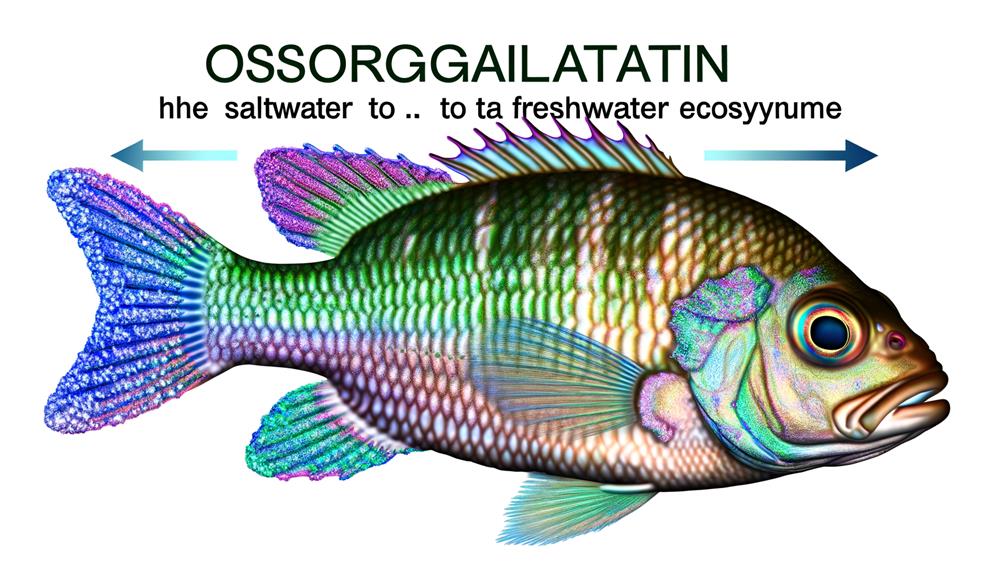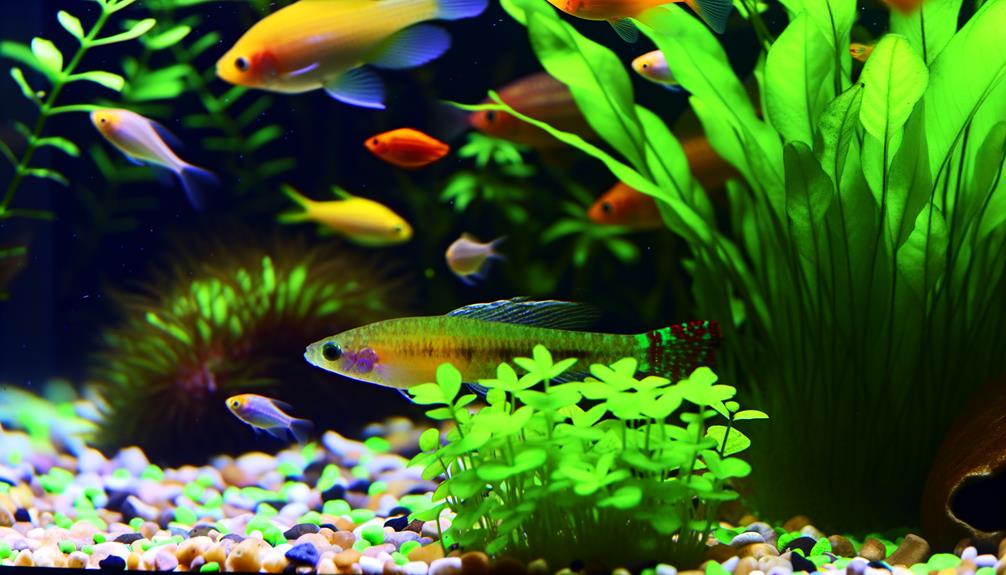The intriguing biological effects of placing a saltwater fish into freshwater provide a fascinating exploration into the field of marine biology. This seemingly simple act triggers a series of physiological events in the fish, primarily driven by osmosis, that expose the profound impact of environmental changes on aquatic organisms.
These changes revolve around the delicate balance of salt and water in the fish's cells, a balance that is drastically disrupted in freshwater. The ensuing complications prompt one to further investigate the survival mechanisms of these marine creatures and the potential exceptions to this fatal outcome.
Key Takeaways
- Saltwater fish experience osmotic stress in freshwater due to significant solute concentration differences.
- The osmotic imbalance in freshwater causes cell swelling and disrupts ion regulation in saltwater fish.
- Freshwater exposure can lead to metabolic regulation failure and organ damage in saltwater fish.
- Some saltwater fish, like Atlantic salmon, can adapt to freshwater due to efficient osmoregulation mechanisms.
Understanding Salinity Differences
Why is understanding salinity differences vital?
Ocean water contains approximately 35 grams of salt per liter, in stark contrast to freshwater which has less than 0.5 grams, illustrating a significant disparity in salinity levels that saltwater fish must navigate when placed in freshwater environments. This difference in salt concentration disrupts the internal salt balance of saltwater fish, leading to osmotic stress, which poses potential health risks.
The intrusion of freshwater causes the cells of saltwater fish to swell due to the increased influx of water, consequently affecting their physiological functions, such as ion regulation and metabolism. The substantial difference in solute concentration between saltwater and freshwater environments is the root cause of this osmotic stress.
Recognizing the physiological differences between saltwater and freshwater fish is crucial to comprehend the challenges that saltwater fish encounter when adapting to environments with varying salinity levels. This knowledge is vital for ensuring the health and survival of saltwater species in our care, fostering a sense of belonging among those interested in marine life and its preservation.
The Role of Osmosis
The role of osmosis in the survival of aquatic life cannot be overemphasized, particularly for saltwater fish transitioning to freshwater environments.
It is crucial to understand the basics of osmosis, which is the movement of water across a semi-permeable membrane from a region of low solute concentration to a region of high solute concentration.
This process significantly impacts the physiological functions of saltwater fish when placed in freshwater, often leading to osmotic stress and potential cellular damage.
Understanding Osmosis Basics
In order to fully comprehend the implications of placing a saltwater fish in freshwater, one must first understand the fundamental concept of osmosis. This process, crucial in cellular biology, involves the movement of liquid molecules through a semipermeable membrane from an area of low solute concentration to an area of high solute concentration.
The semipermeable membrane facilitates this movement by only allowing smaller molecules to pass through. This migration of molecules creates osmotic pressure, which increases as water moves into higher concentrated solutions.
The term tonicity – classified into hypertonicity, isotonicity, and hypotonicity – measures this osmotic pressure within a solution. Imbalances in tonicity can lead to significant cell volume changes, underscoring the essential role of osmosis in maintaining cellular integrity.
Osmosis in Aquatic Life
Navigating through diverse aquatic environments, fish leverage the process of osmosis to maintain cellular salt balance, thereby demonstrating the integral role of osmosis in aquatic life. The osmoregulation in fish cells is a dynamic interplay between water environments, solute concentration, and the osmotic pressure. Here is an overview:
| Aspect | Freshwater Habitats | Saltwater Environments |
|---|---|---|
| Osmosis | Moves water into fish cells | Removes water from fish cells |
| Salt Balance | Diffuses salts out of the fish | Forces salts into fish cells |
| Osmoregulation | Fish excrete excess water | Fish drink more water & excrete salt |
This table succinctly illustrates how freshwater and saltwater fish adapt their osmoregulatory mechanisms to survive, highlighting the crucial role of semipermeable membranes in osmosis. Understanding these concepts helps explain the challenges faced by saltwater fish in freshwater habitats.
Saltwater Fish Physiology

Saltwater fish have evolved various physiological adaptations to thrive in their hypertonic marine habitats, which is a stark contrast to the conditions in a freshwater environment.
The transition from saltwater to freshwater can impose severe osmotic stress on these marine organisms, disturbing their salt balance and leading to detrimental cellular and metabolic disturbances.
The discussion will further explore these physiological challenges and the underlying principles of survival in both saline and freshwater habitats.
Adaptations for Saline Habitats
Adaptations in the physiology of saltwater fish, specifically their specialized organs, allow them to regulate salt levels effectively for survival in marine environments with high salinity. These adaptions optimize their metabolism for marine conditions, impacting their ability to osmoregulate in freshwater. In the event of a sudden shift to freshwater, these fish experience osmotic stress, leading to cell swelling and disrupted ion regulation.
| Physiological Adaptations | Impact |
|---|---|
| Specialized organs | Enable salt balance regulation |
| Metabolic optimization | Facilitates survival in saline habitats |
| Osmotic stress response | Leads to cell swelling and ion regulation disruption |
| Inefficient salt absorption in freshwater | Causes disruptions in salt balance |
Understanding these physiological adaptations is crucial for their conservation and management in changing aquatic environments.
Saltwater Vs Freshwater Survival
Building upon the understanding of a saltwater fish's physiological adaptations, it becomes pertinent to analyze how these adaptations impact their survival when exposed to freshwater environments.
- Saltwater fish survival is compromised in freshwater due to a disruptive salt concentration imbalance, causing cells to absorb excess water and swell.
- Metabolic regulation failure in a freshwater environment induces physiological stress and can lead to organ damage in saltwater fish.
- The cells of saltwater fish not only swell but also disrupt essential body functions due to excess water intake.
- The regulatory mechanisms that help saltwater fish survive in their natural habitat fail to maintain osmotic balance in freshwater, resulting in cell damage.
- Death can occur if a saltwater fish cannot regulate osmotic pressure in freshwater, emphasizing the necessity of appropriate salinity levels for survival.
Freshwater Vs Saltwater: Fish Survival
When a saltwater fish is placed in a freshwater environment, its cells swell due to an influx of water, disrupting metabolic processes and impairing the fish's ability to regulate crucial body functions. This cell swelling is a consequence of a disrupted salt balance. In the saltwater habitat, these fish maintain a delicate equilibrium of salt levels, a process known as osmoregulation. The transition to freshwater, where salt levels are significantly lower, interferes with this internal balance.
The physiological issues associated with this transition are profound. The fish's ability to osmoregulate is compromised, leading to an imbalance in salt levels that is detrimental to its health. This disrupted salt balance triggers a cascade of events that ultimately result in cell damage. The fish's cells, inundated with water, begin to swell and disrupt metabolic processes which are central to survival. Without the ability to effectively regulate these processes, the fish's internal functioning deteriorates, culminating in death if the fish cannot adapt to the freshwater environment.
Thus, the survival of saltwater fish in freshwater is a complex and challenging issue that entails maintaining a delicate internal balance in a constantly changing external environment.
Osmoregulation in Fish

Understanding the intricate process of osmoregulation in fish provides further insight into their survival mechanisms, particularly how they maintain water balance and regulate salt levels in their bodies. This physiological process is critical to their well-being and differs significantly between freshwater and saltwater fish.
Freshwater fish face a constant challenge of excessive water intake due to a hypotonic environment. They need to urinate frequently to expel excess water and keep the salt levels in their bodies regulated, thereby maintaining their water balance for optimal cellular function.
Saltwater fish, on the other hand, live in hypertonic seawater which draws water out of their bodies. To compensate for this water loss, they drink water actively and excrete concentrated urine to eliminate excess salts.
Some exceptional fish species have adapted to survive in both environments. They can modify their osmoregulatory mechanisms to withstand drastic changes in water salinity.
Osmoregulation in fish is not a static process. It involves a dynamic balance of water intake and salt level regulation, ensuring their survival in diverse habitats.
Disruption in osmoregulation can greatly affect a fish's ability to survive, emphasizing the importance of this physiological process in their life cycle.
Saltwater Fish in Freshwater: The Impact
Moving a saltwater fish into a freshwater environment induces a profound shift in its physiological mechanisms, primarily causing its cells to absorb excessive water and rupture due to the increased osmotic pressure. This occurrence, known as osmoregulation, signifies the fish's ability to maintain a stable internal balance of salts and water, which is vital for survival. The disruption of this equilibrium in a freshwater environment results in significant cell damage and metabolic processes failure.
| Challenges | Impact | Result |
|---|---|---|
| Water Imbalance | Excessive water absorption | Bloating |
| Salt Imbalance | Disruption in metabolic processes | Regulatory mechanisms failure |
| Cell Damage | Rupture due to osmotic pressure | Hypotonic condition |
The fish's body becomes hypotonic, leading to an increased water influx into the cells. This water imbalance causes bloating and further cell damage, negatively impacting the fish's overall survival. The transition from a saltwater to a freshwater environment overwhelms the regulatory mechanisms of the fish, leading to their eventual failure. Thus, these poignant impacts illustrate the importance of understanding the significant differences between saltwater and freshwater environments for the preservation of fish health.
Notable Survival Exceptions

Despite the harsh consequences of transitioning from saltwater to freshwater environments for most species, certain saltwater fish, such as the Atlantic salmon, exhibit remarkable survival flexibility, demonstrating their ability to thrive in both high and low salinity conditions. These fish can live and survive in highly concentrated saltwater environments and adapt to freshwater environments, largely due to their unique osmoregulation abilities.
These abilities enable such species to maintain an optimal internal salt balance, a crucial aspect of survival in both environments. This adaptability is a testament to nature's resilience and a fascinating exception to the norm. Here are some key points that illustrate this:
- The Atlantic salmon's adaptability to both saltwater and freshwater environments.
- The importance of osmoregulation in maintaining internal salt balance.
- The balance between high salinity conditions and osmoregulation abilities.
- The role of adaptability in survival in diverse water environments.
- The remarkable survival flexibility of certain saltwater fish species.
Understanding these survival exceptions provides valuable insights into the adaptability and resilience of life in aquatic ecosystems, reminding us of the importance of preserving these intricate balances in nature.
Mitigating Salinity Change Effects
While certain species exhibit remarkable resilience to changing salinities, most saltwater and freshwater fish are highly sensitive to these alterations, which can disrupt physiological functions and lead to serious health consequences if not mitigated effectively. The primary issue arises when their bodies, heavily concentrated in salt solution, are exposed to surrounding water with different salt levels.
For instance, when freshwater fish are placed in saltwater, their bodies cannot handle the excess salt, leading to a chain reaction of problems like dehydration and disrupted cellular functions. Conversely, the cells of saltwater fish begin swelling when placed in freshwater due to water influx, often resulting in death.
To mitigate these effects, maintaining appropriate salt levels in freshwater and saltwater habitats is paramount. It's crucial to understand that while some may question, 'can't saltwater fish live in freshwater?' the answer largely depends on the fish's ability to osmoregulate in response to salinity changes.
Frequently Asked Questions
What Happens if You Put a Saltwater Fish in a Freshwater?
When a saltwater fish is placed in freshwater, osmotic shock effects occur, disrupting fish physiology and aquatic adaptations. This impacts gills and causes cellular repercussions, leading to freshwater intolerance and significant environmental stress impacts on survival strategies.
How Long Can Saltwater Fish Survive in Freshwater?
Saltwater fish's survival duration in freshwater is brief due to osmoregulation challenges, stress symptoms, and physiological changes. Salinity impact disrupts gills function and protective mechanisms, often leading to death without successful freshwater adaptation.
What Saltwater Fish Can Live in Freshwater?
Certain euryhaline species exhibit exceptional salinity tolerance, with their osmoregulation differences allowing survivability in both saltwater and freshwater environments. Notably, Atlantic salmon and bull sharks can adapt to the freshwater dangers and thrive in varying aquatic environments.
What Would Happen to the Fish if a Marine Fish Is Kept in Freshwater?
When a marine fish is kept in freshwater, osmotic shock impact can occur. The saltwater fish's adaptations, such as salinity tolerance, are disrupted, affecting its physiology, metabolism, survival mechanisms, and potentially leading to mortality.
Conclusion
The abrupt shift in salinity when transitioning a saltwater fish to a freshwater environment triggers a fatal osmotic imbalance. This disrupts cellular functions, metabolic processes, and overall fish physiology, leading to cell rupture and ultimately, death.
Exceptions are rare, underscoring the importance of maintaining appropriate salinity parameters for aquatic species.
Continued research into osmoregulation can potentially mitigate the effects of salinity changes, safeguarding fish health and ensuring the survival of diverse aquatic ecosystems.


